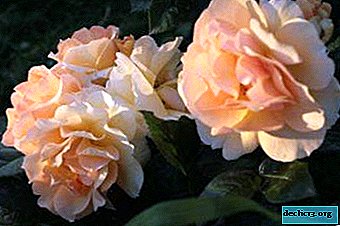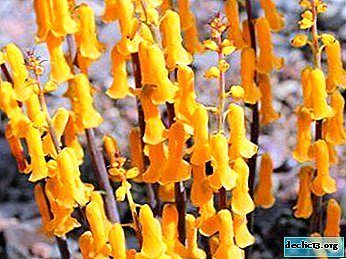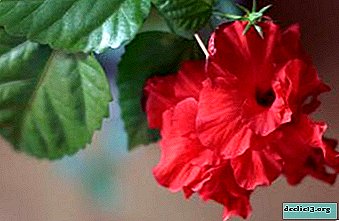Abundantly blooming view of a geisha garden rose: cultivation features, description and photo of a flower

Rose Geisha is an abundantly flowering hybrid species of rose. The flower is well suited for growing in climatic conditions of central Russia.
It tolerates both intense heat and moderate cold. Therefore, the flower will delight you with flowering for a long time.
In the article, we will study the description and general characteristics of the flower, find out which plants can be combined in landscape design, and also consider how to properly care for a Geisha rose.
Description and general characteristics
Rose Geisha belongs to the group of garden roses Floribunda. It was bred by Tantau breeders in 2007. This group of gardeners is distinguished for long and plentiful flowering, bright colors and a pleasant delicate aroma. The bush reaches growth up to 1 m, while its width does not exceed 0.6 m. Bright green leaves, which have a slight gloss, do not fade, rarely are infected with diseases.
Rose flowers are semi-double, apricot-orange. The petals located in the center of the rose never open completely, they are small and straight. The outer petals are large, bent down.
Features
Benefits of growing a geisha rose:
- Well suited for creating a large flower garden, and for the formation of small flower groups.
- It has the ability to bloom three times per season.
- Withstands many adverse weather conditions: cold (up to -23 ° C), drought, high humidity.
- Resistant to diseases and pests.
- Cut flowers last up to 10 days.
The disadvantages of this type of rose include:
- Weak aroma. It feels good only in calm weather.
- With insufficient lighting, the stems of the flower begin to stretch very much, and the flowers discolor to white.
Rose geisha was Bred by Tantau breeders in 2007.
Garden design
A rose of this species goes well with ornamental conifers (spruce, thuja, juniper), stunted lilacs, cotoneaster, sea buckthorn and acacia bushes. One of the winning combinations is a combination of roses and magonia or pyrocanth.
In flower beds, it can be planted with grassy perennials with leaves or having flowers in blue, blue, silver or lilac colors.Photo
Here you can see a photo of a geisha rose:




Growing
Three years after planting, the rose reaches maturity. At this point, the root system ceases to develop.
Subject to the technology of planting this type of flower, there is a high probability of obtaining good tall bushes with abundant continuous flowering:
- Landing is best done in the spring.
- The plot on which the Geisha rose planted should be spacious and open, well-lit and protected from cold winds.
- Soil preparation begins no later than 2 weeks before the start of disembarkation.
- The size of the pit for the seedling: 0.4 m in all directions.
- The distance between the rows: 60 cm, and the distance between the bushes: 40 cm.
- You can plant a rose in wooden boxes or large pots.
- Seedlings cannot be rooted in lowlands, in order to avoid excessive moisture accumulation.
- The soil must have high breathability. To do this, before planting it must be thoroughly loosened, and after disembarking for some time regularly carry out loosening.
- The soil of the soil intended for planting is mixed with sand and humus in a ratio of 1: 4.
- Do not plant a geisha rose along fences or other possible sources of shade.
- Immediately before planting, the roots of the seedling are placed in a solution that stimulates growth, for safe and intensive subsequent rooting.
- Immediately after planting, you need to irrigate and mulch the soil. This will help protect the plant from pests and maintain soil moisture.
- The abundant flowering of this rose variety requires high energy consumption and needs active recharge.
 Plant care includes the following features:
Plant care includes the following features:
- Watering only if the soil is completely dry.
- For a medium-sized bush, the volume of water for a single watering is about 5-7 liters.
- Watering is carried out under the root of the plant, since it is better to protect the leaves and flowers of the rose from moisture.
- After watering, the soil must be loosened.
- Regularly remove all weeds.
- In the soil around the bush, you sometimes need to make sawdust and hay. This will help retain moisture.
- For the correct decorative formation of the bush, in the first year after its planting, you need to pinch the shoots and remove the buds, allowing the rose to bloom only at the end of summer.
- Spring processing of the bush includes cutting the bush to 50 cm. Pruning is carried out after the first buds appear. For an annual plant, pruning is one third of the entire bush; in subsequent years, the rose is cut to the fifth bud.
- Fertilizing fertilizers after winter is carried out with a solution of urea, and at the end of summer with phosphorus, potassium fertilizers and ash.
From the video, we will clearly see how to correctly trim the rose:
Transplant technology
Plant transplantation is carried out according to the following conditions:
- Geisha rose transplantation begins with the selection of a new location. According to the conditions, it should not differ from the previous one: the presence of the same degree of illumination and protection from winds is mandatory.
- Next, you need to prepare the soil and the pit, similar to the preparation before planting a seedling, and remove all weeds and their roots.
- To complete the preparation of a new place, he needs to be allowed to stand for a while, to allow the earth to settle.
- Then the bush can be dug up and replanted. It is necessary to try to dig a plant with a large lump of earth, and transplant with it.
Breeding
 Propagation of the plant is mainly carried out by cuttings. The cuttings are separated when the shoots are already stiff.
Propagation of the plant is mainly carried out by cuttings. The cuttings are separated when the shoots are already stiff.
- Cuttings are cut 8 cm long, while the upper cut is made straight, and the bottom is 45 °.
- The cutlery is placed in the ground to almost half.
- A hole for landing is made with a depth of 15 cm.
- The distance between the cuttings is allowed no more than 30 cm.
- One of the sides of the landing hole is made strictly vertical, in which case the rose will grow straight and slender.
- After planting, the cuttings are covered with a film, provide them with regular watering and loosening of the soil near them.
- The first buds should be removed so as not to inhibit the development of the root system.
Diseases and Pests
The rose is susceptible to diseases due to excessive waterlogging of part of the plantlocated above the ground, or with insufficient intake of air to the roots. Provoke diseases and overgrown weeds.
The main pests affecting rose bushes are aphids and spider mites. Of the diseases most often develop ailments caused by root rot and mold.
As a preventive measure, it is necessary to monitor the level of soil moisture and carry out systematic cultivation.
Possible mistakes
Some mistakes may be made in breeding a geisha rosethat can adversely affect the plant:
 Incorrect landing site selection. Correct the situation can immediately prepare the plant for transplantation to a more suitable place.
Incorrect landing site selection. Correct the situation can immediately prepare the plant for transplantation to a more suitable place.- Incorrect pruning of roses. It is necessary to prune withered flowers in the summer. Otherwise, the plant will begin to prepare for winter, its biological rhythm will be disrupted.
- Ignoring flowerless shoots. To make the bush more lush and blooming, shoots that do not have flowers are activated by cutting.
- Surface watering (the plant remains not watered). To remedy the situation, before watering, dig a small hole around the roots (12-15 cm), fill it with settled water, bury the hole after the water is completely soaked.
- Choosing the wrong time for watering. If the flowers were watered during the day, especially in the scorching sun, this causes burns to the leaves and petals. Affected petals and leaves can be cut off by watering in the evening.
- Fertilizer overuse. A plant oversaturated with fertilizers can be saved by abundant watering.
The unpretentious rose Geisha can live for more than a dozen years, subject to a well-developed root system. Danger exists for a grafted plant that is not well rooted. Roses with a poor root system survive to a maximum of 5 to 10 years.

 Incorrect landing site selection. Correct the situation can immediately prepare the plant for transplantation to a more suitable place.
Incorrect landing site selection. Correct the situation can immediately prepare the plant for transplantation to a more suitable place.















